Novel Uses of Al2O3/Mos2 Hybrid Nanofluid in MQCL Hard Milling of Hardox 500 Steel
Abstract
1. Introduction
2. Material and Method
2.1. Experimental Set Up
2.2. Experiment Design
3. Results and Discussion
3.1. The Effects of Input Machining Variables on Surface Roughness
3.2. Investigation of Surface Microstructure
4. Conclusions
Author Contributions
Funding
Acknowledgments
Conflicts of Interest
Appendix A
| Source | DF | Adj SS | Adj MS | F-Value | p-Value |
|---|---|---|---|---|---|
| Model | 9 | 0.025516 | 0.002835 | 15.93 | 0.000 |
| Linear | 3 | 0.021606 | 0.007202 | 40.46 | 0.000 |
| NC | 1 | 0.000827 | 0.000827 | 4.64 | 0.044 |
| Vc | 1 | 0.002756 | 0.002756 | 15.49 | 0.001 |
| F | 1 | 0.018023 | 0.018023 | 101.26 | 0.000 |
| Square | 3 | 0.002368 | 0.000789 | 4.44 | 0.015 |
| NC*NC | 1 | 0.000111 | 0.000111 | 0.62 | 0.439 |
| Vc*Vc | 1 | 0.000814 | 0.000814 | 4.57 | 0.045 |
| F*F | 1 | 0.001689 | 0.001689 | 9.49 | 0.006 |
| 2-way interaction | 3 | 0.001542 | 0.000514 | 2.89 | 0.061 |
| NC*Vc | 1 | 0.000190 | 0.000190 | 1.07 | 0.314 |
| NC*F | 1 | 0.000722 | 0.000722 | 4.06 | 0.058 |
| Vc*F | 1 | 0.000630 | 0.000630 | 3.54 | 0.075 |
| Error | 20 | 0.003560 | 0.000178 | ||
| Lack-of-Fit | 3 | 0.000045 | 0.000015 | 0.07 | 0.974 |
| Pure Error | 17 | 0.003515 | 0.000207 | ||
| Total | 29 | 0.029076 |
References
- Cappellini, C.; Attanasio, A.; Rotella, G.; Umbrello, D. Formation of white and dark layers in hard cutting: Influence of tool wear. Int. J. Mater. Form. 2010, 3, 455–458. [Google Scholar] [CrossRef]
- Davim, J.P. Machining of Hard Materials; Springer: London, UK, 2011. [Google Scholar]
- Duc, T.M.; Long, T.T. Investigation of MQL-employed hard-milling process of S60C steel using coated-cemented carbide tools. J. Mech. Eng. Autom. 2016, 6, 128–132. [Google Scholar]
- Hassanpour, H.; Sadeghi, M.H.; Rasti, A.; Shajari, S. Investigation of surface roughness, microhardness and white layer thick-ness in hard milling of AISI 4340 using minimum quantity lubrication. J. Cleaner Prod. 2016, 120, 124–134. [Google Scholar] [CrossRef]
- Çalışkan, H.; Kurbanoğlu, C.; Panjan, P.; Čekada, M.; Kramar, D. Wear behavior and cutting performance of nanostructured hard coatings on cemented carbide cutting tools in hard milling. Tribol. Int. 2013, 62, 215–222. [Google Scholar] [CrossRef]
- Zhang, K.; Deng, J.; Meng, R.; Gao, P.; Yue, H. Effect of nano-scale textures on cutting performance of WC/Co-based Ti55Al45N coated tools in dry cutting. Int. J. Refract. Met. Hard Mater. 2015, 51, 35–49. [Google Scholar] [CrossRef]
- Kumar, C.S.; Patel, S.K. Effect of WEDM surface texturing on Al2O3/TiCN composite ceramic tools in dry cutting of hardened steel. Ceram. Int. 2018, 44, 2510–2523. [Google Scholar] [CrossRef]
- Bouacha, K.; Yallese, M.A.; Mabrouki, T.; Rigal, J.-F. Statistical analysis of surface roughness and cutting forces using response surface methodology in hard turning of AISI 52100 bearing steel with CBN tool. Int. J. Refract. Met. Hard Mater. 2010, 28, 349–361. [Google Scholar] [CrossRef]
- Su, Y.; Li, Z.; Li, L.; Wang, J.; Gao, H.; Wang, G. Cutting performance of micro-textured polycrystalline diamond tool in dry cutting. J. Manuf. Process. 2017, 27, 1–7. [Google Scholar] [CrossRef]
- Ekinovic, S.; Prcanovic, H.; Begovic, E. Investigation of Influence of MQL Machining Parameters on Cutting Forces During MQL Turning of Carbon Steel St52-3. Procedia Eng. 2015, 132, 608–614. [Google Scholar] [CrossRef]
- Rahim, E.A.; Dorairaju, H. Evaluation of mist flow characteristic and performance in Minimum Quantity Lubrication (MQL) machining. Measurement 2018, 123, 213–225. [Google Scholar] [CrossRef]
- Khan, M.; Mithu, M.; Dhar, N. Effects of minimum quantity lubrication on turning AISI 9310 alloy steel using vegetable oil-based cutting fluid. J. Mater. Process. Technol. 2009, 209, 5573–5583. [Google Scholar] [CrossRef]
- de Lacalle, L.L.; Angulo, C.; Lamikiz, A.; Sánchez, J. Experimental and numerical investigation of the effect of spray cutting fluids in high speed milling. J. Mater. Process. Technol. 2006, 172, 11–15. [Google Scholar] [CrossRef]
- Pereira, O.; Martín-Alfonso, J.; Rodríguez, A.; Calleja, A.; Fernández-Valdivielso, A.; de Lacalle, L.L. Sustainability analysis of lubricant oils for minimum quantity lubrication based on their tribo-rheological performance. J. Clean. Prod. 2017, 164, 1419–1429. [Google Scholar] [CrossRef]
- Pereira, O.; Celaya, A.; Urbikaín, G.; Rodríguez, A.; Fernández-Valdivielso, A.; De Lacalle, L.N.L. CO2 cryogenic milling of Inconel 718: Cutting forces and tool wear. J. Mater. Res. Technol. 2020, 9, 8459–8468. [Google Scholar] [CrossRef]
- Pereira, O.; Urbikain, G.; Rodríguez, A.; Fernández-Valdivielso, A.; Calleja, A.; Ayesta, I.; De Lacalle, L.N.L. Internal cryolubrication approach for Inconel 718 milling. Procedia Manuf. 2017, 13, 89–93. [Google Scholar] [CrossRef]
- Pereira, O.; Català, P.; Rodríguez, A.; Ostra, T.; Vivancos, J.; Rivero, A.; López-De-Lacalle, L. The Use of Hybrid CO2+MQL in Machining Operations. Procedia Eng. 2015, 132, 492–499. [Google Scholar] [CrossRef]
- Pereira, O.; Rodríguez, A.; Fernández-Abia, A.; Barreiro, J.; de Lacalle, L.L. Cryogenic and minimum quantity lubrication for an eco-efficiency turning of AISI 304. J. Clean. Prod. 2016, 139, 440–449. [Google Scholar] [CrossRef]
- Minh, D.T.; The, L.T.; Bao, N.T. Performance of Al2O3 nanofluids in minimum quantity lubrication in hard milling of 60Si2Mn steel using cemented carbide tools. Adv. Mech. Eng. 2017, 9, 1–9. [Google Scholar] [CrossRef]
- Wong, K.V.; De Leon, O. Applications of Nanofluids: Current and Future. Adv. Mech. Eng. 2010, 2, 519659. [Google Scholar] [CrossRef]
- Jarahnejad, M.; Haghighi, E.B.; Saleemi, M.; Nikkam, N.; Khodabandeh, R.; Palm, B.; Toprak, M.S.; Muhammed, M. Experimental investigation on viscosity of water-based Al2O3 and TiO2 nanofluids. Rheol. Acta 2015, 54, 411–422. [Google Scholar] [CrossRef]
- Lee, G.-J.; Park, J.-J.; Lee, M.-K.; Rhee, C.K. Stable dispersion of nanodiamonds in oil and their tribological properties as lubricant additives. Appl. Surf. Sci. 2017, 415, 24–27. [Google Scholar] [CrossRef]
- Ali, M.K.A.; Xianjun, H.; Mai, L.; Qingping, C.; Turkson, R.F.; Bicheng, C. Improving the tribological characteristics of piston ring assembly in automotive engines using Al2O3 and TiO2 nanomaterials as nano-lubricant additives. Tribol. Int. 2016, 103, 540–554. [Google Scholar] [CrossRef]
- Sinha, M.K.; Madarkar, R.; Ghosh, S.; Rao, P.V. Application of eco-friendly nanofluids during grinding of Inconel 718 through small quantity lubrication. J. Clean. Prod. 2017, 141, 1359–1375. [Google Scholar] [CrossRef]
- Sharma, A.K.; Tiwari, A.K.; Dixit, A.R. Effects of Minimum Quantity Lubrication (MQL) in machining processes using conventional and nanofluid based cutting fluids: A comprehensive review. J. Clean. Prod. 2016, 127, 1–18. [Google Scholar] [CrossRef]
- Sidik, N.A.C.; Samion, S.; Ghaderian, J.; Yazid, M.N.A.W.M. Recent progress on the application of nanofluids in minimum quantity lubrication machining: A review. Int. J. Heat Mass Transf. 2017, 108, 79–89. [Google Scholar] [CrossRef]
- Pasam, V.K.; Revuru, R.S.; Gugulothu, S. Comparing the performance & viability of nano and microfluids in minimum quantity lubrication for machining AISI1040 steel. Mater. Today Proc. 2018, 5, 8016–8024. [Google Scholar] [CrossRef]
- Hegab, H.; Kishawy, H.A.; Gadallah, M.H.; Umer, U.; Deiab, I. On machining of Ti-6Al-4V using multi-walled carbon nanotubes-based nano-fluid under minimum quantity lubrication. Int. J. Adv. Manuf. Technol. 2018, 97, 1593–1603. [Google Scholar] [CrossRef]
- Hegab, H.; Umer, U.; Soliman, M.; Kishawy, H.A. Effects of nano-cutting fluids on tool performance and chip morphology during machining Inconel 718. Int. J. Adv. Manuf. Technol. 2018, 96, 3449–3458. [Google Scholar] [CrossRef]
- Hegab, H.; Umer, U.; Deiab, I.; Kishawy, H. Performance evaluation of Ti–6Al–4V machining using nano-cutting fluids under minimum quantity lubrication. Int. J. Adv. Manuf. Technol. 2018, 95, 4229–4241. [Google Scholar] [CrossRef]
- Sharma, A.K.; Tiwari, A.K.; Dixit, A.R.; Singh, R.K.; Singh, M. Novel uses of alumina/graphene hybrid nanoparticle additives for improved tribological properties of lubricant in turning operation. Tribol. Int. 2018, 119, 99–111. [Google Scholar] [CrossRef]
- Sharma, A.K.; Singh, R.K.; Dixit, A.R.; Tiwari, A.K. Novel uses of alumina-MoS2 hybrid nanoparticle enriched cutting fluid in hard turning of AISI 304 steel. J. Manuf. Process. 2017, 30, 467–482. [Google Scholar] [CrossRef]
- Singh, R.K.; Sharma, A.K.; Dixit, A.R.; Tiwari, A.K.; Pramanik, A.; Mandal, A. Performance evaluation of alumina-graphene hybrid nano-cutting fluid in hard turning. J. Clean. Prod. 2017, 162, 830–845. [Google Scholar] [CrossRef]
- Duc, T.M.; Long, T.T.; Chien, T.Q. Performance Evaluation of MQL Parameters Using Al2O3 and MoS2 Nanofluids in Hard Turning 90CrSi Steel. Lubr. 2019, 7, 40. [Google Scholar] [CrossRef]
- Dong, P.Q.; Duc, T.M.; Long, T.T. Performance Evaluation of MQCL Hard Milling of SKD 11 Tool Steel Using MoS2 Nanofluid. Metals 2019, 9, 658. [Google Scholar] [CrossRef]
- Duc, T.M.; Long, T.T.; Dong, P.Q. Effect of the alumina nanofluid concentration on minimum quantity lubrication hard machining for sustainable production. Proc. Inst. Mech. Eng. Part. C J. Mech. Eng. Sci. 2019, 233, 5977–5988. [Google Scholar] [CrossRef]
- Duc, T.M.; Long, T.T.; Van Thanh, D. Evaluation of minimum quantity lubrication and minimum quantity cooling lubrication performance in hard drilling of Hardox 500 steel using Al2O3 nanofluid. Adv. Mech. Eng. 2020, 12, 1–12. [Google Scholar] [CrossRef]
- Rahmati, B.; Sarhan, A.A.; Sayuti, M. Morphology of surface generated by end milling AL6061-T6 using molybdenum di-sul-fide (MoS2) nanolubrication in end milling machining. J. Clean. Prod. 2014, 66, 685–691. [Google Scholar] [CrossRef]
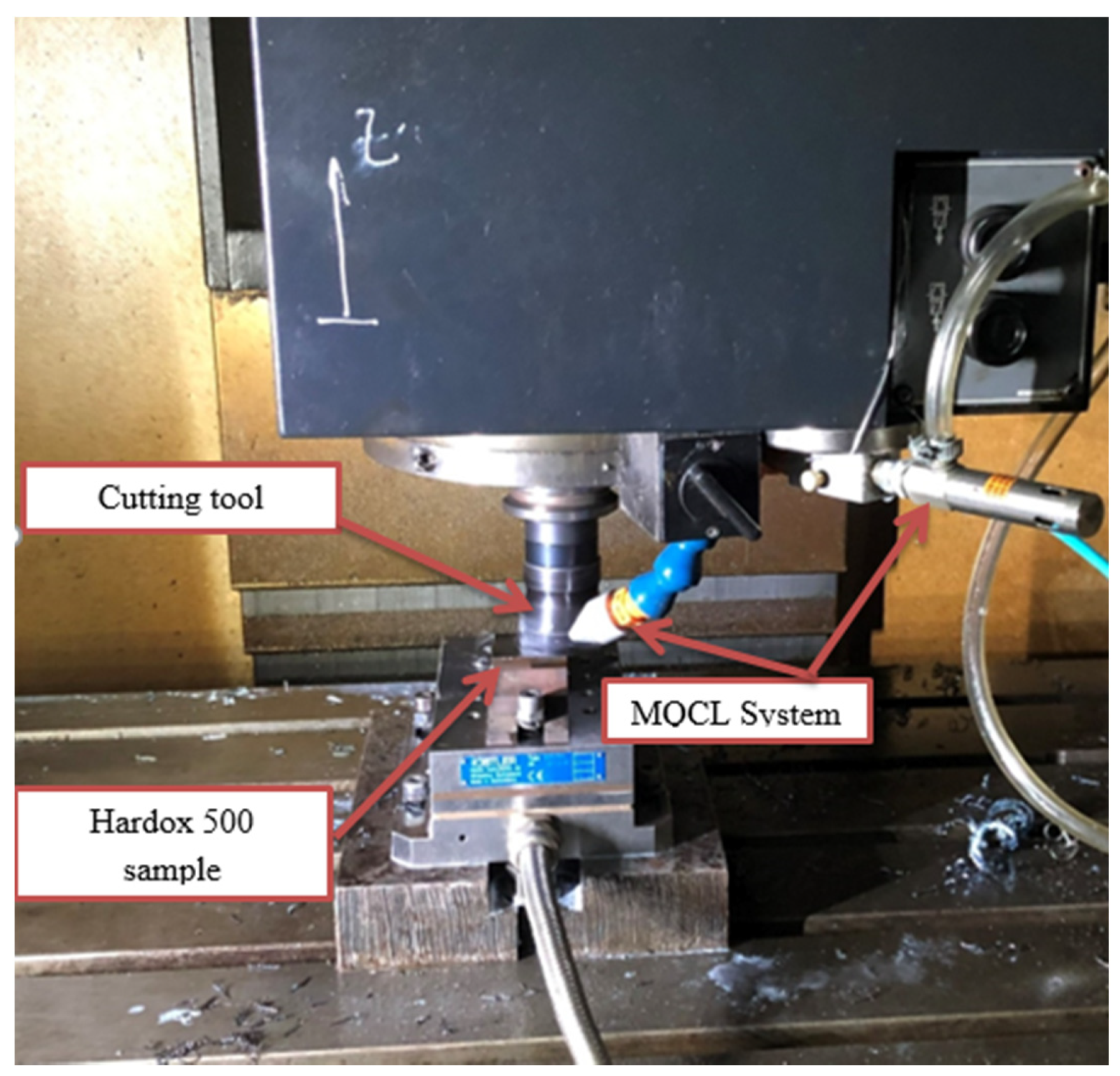
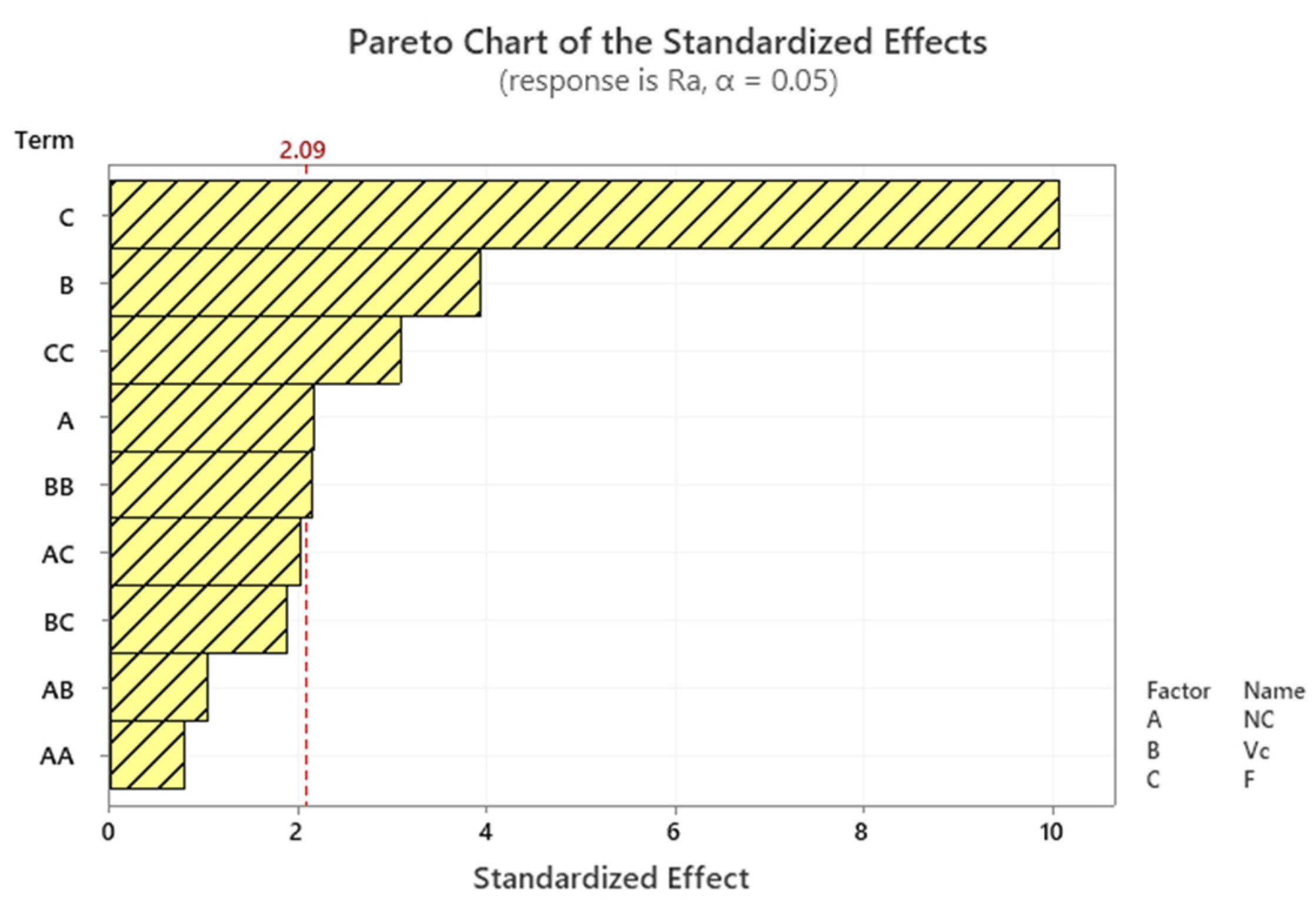
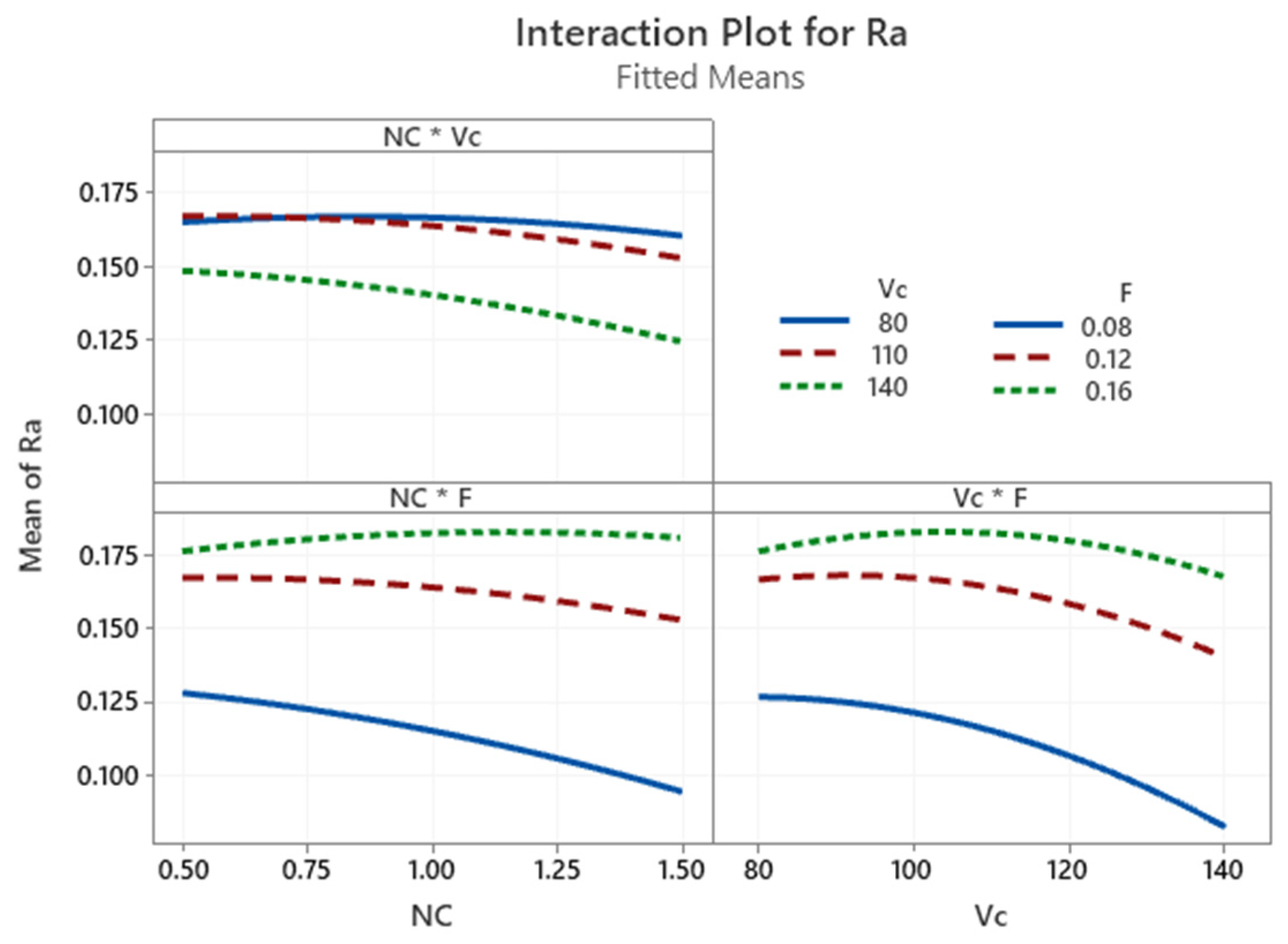

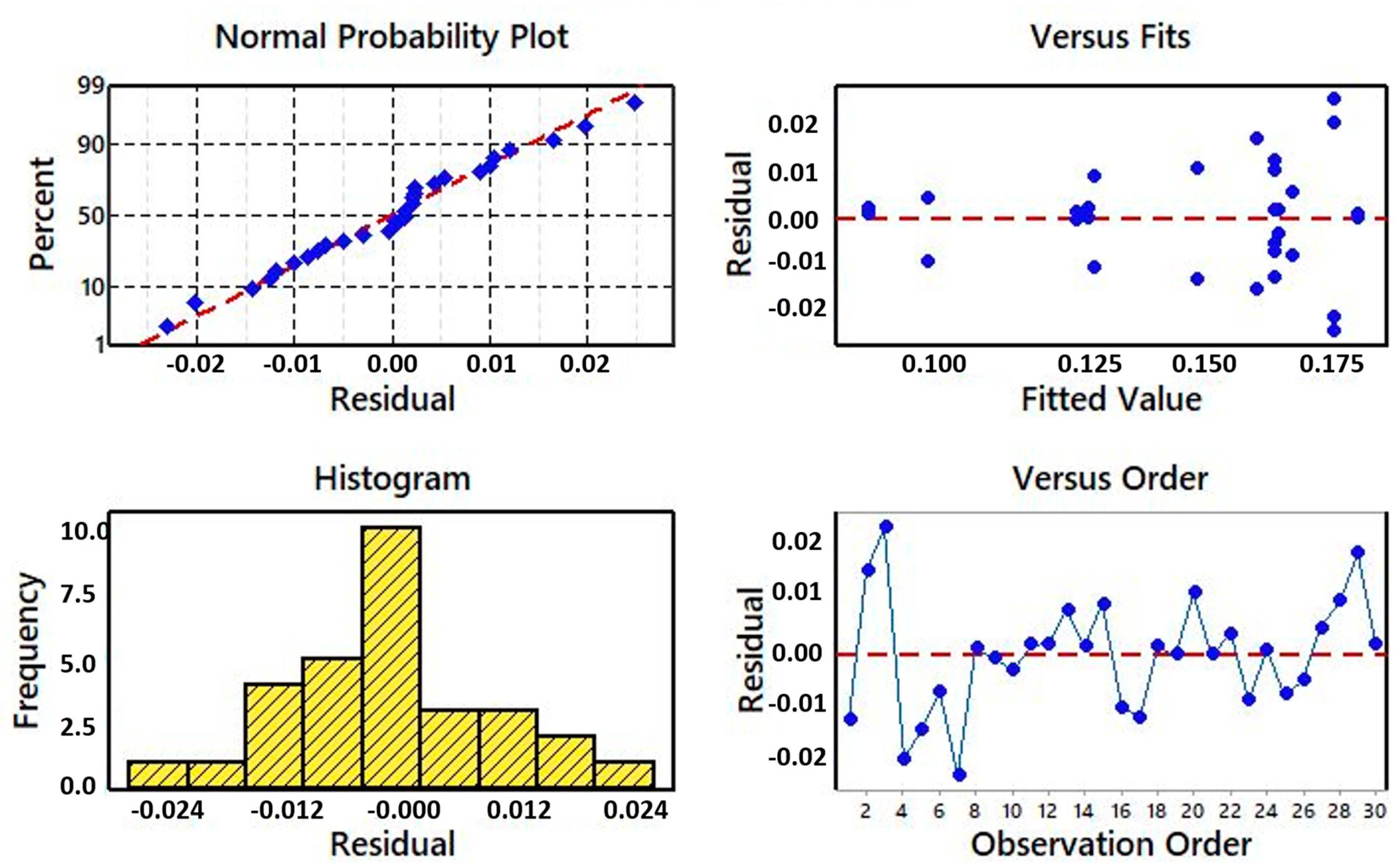

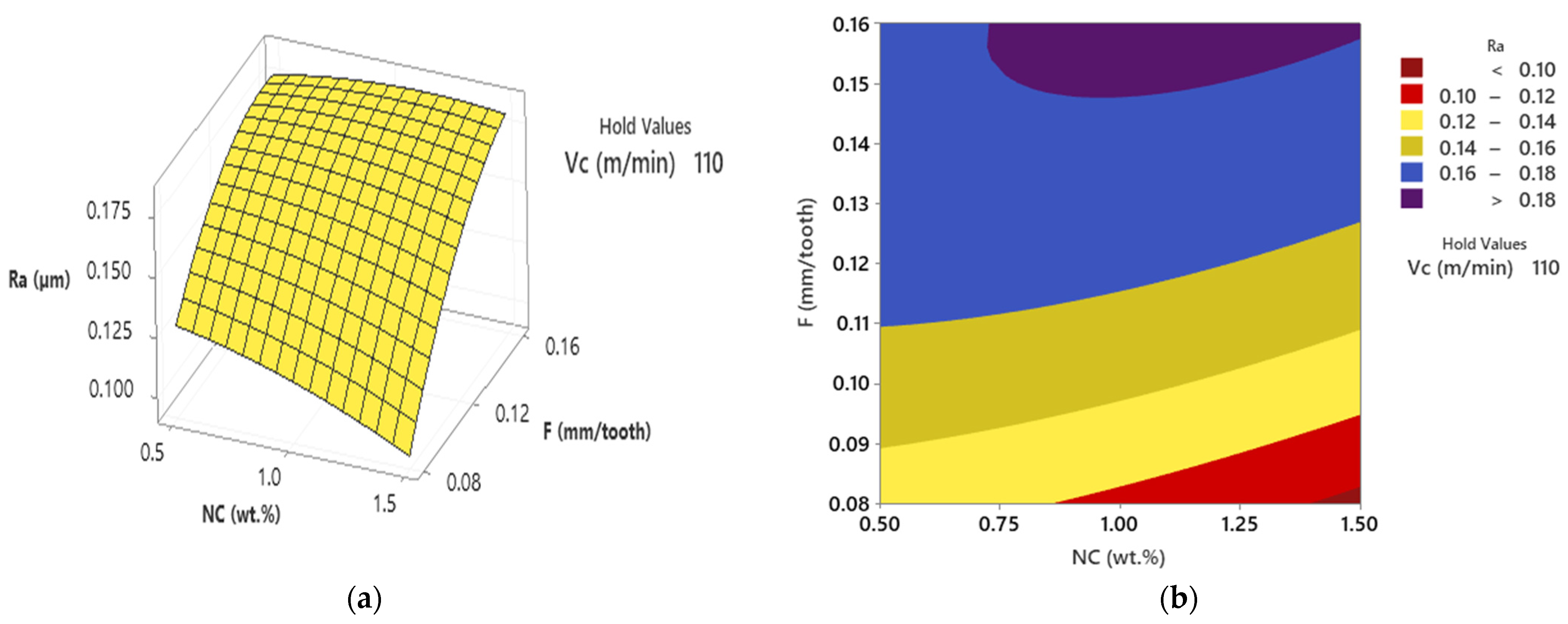
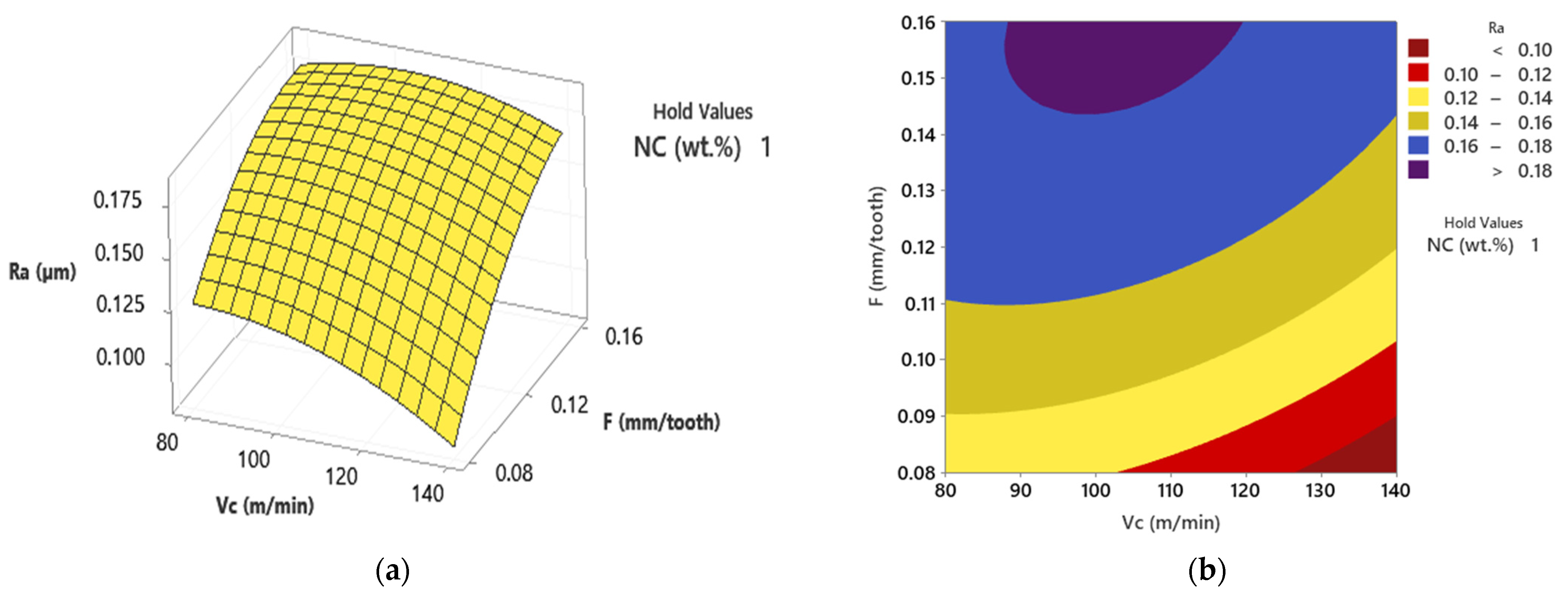
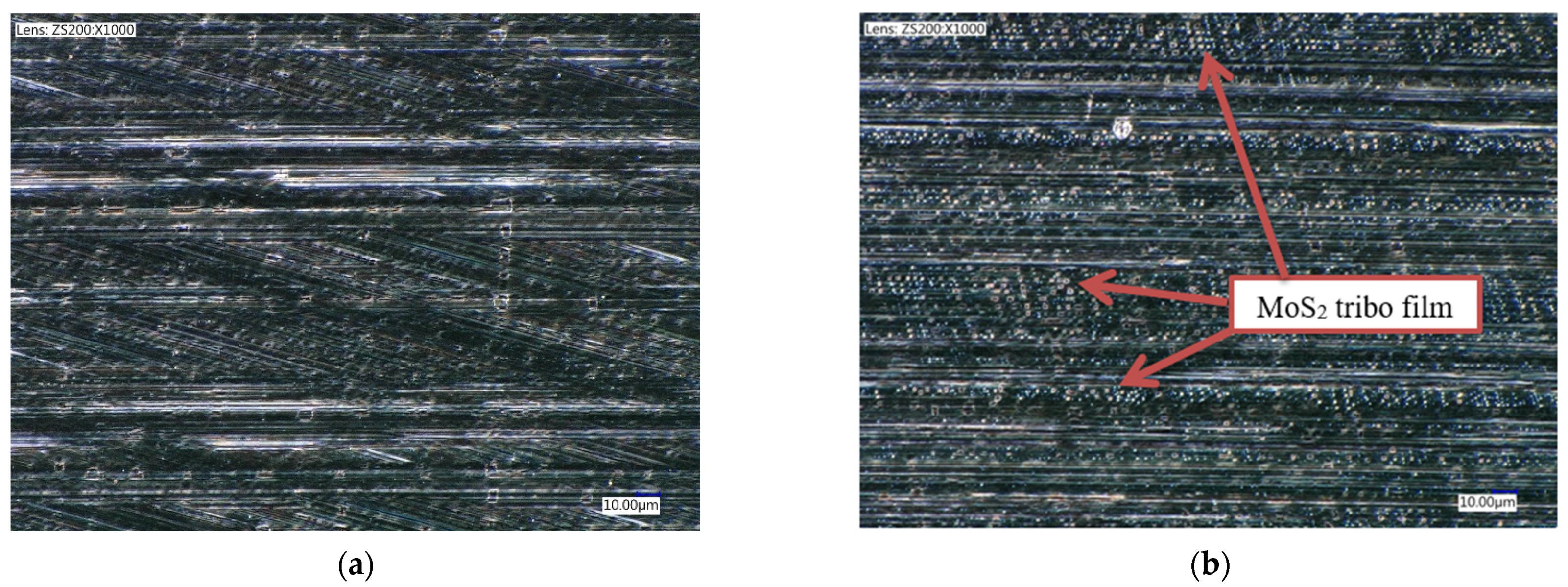
| Input Machining Variables | Unit | Symbol | Level | |
|---|---|---|---|---|
| Low | High | |||
| Nanoparticle concentration | wt.% | NC | 0.5 | 1.5 |
| Cutting speed | m/min | Vc | 80 | 140 |
| Feed rate | mm/tooth | F | 0.08 | 0.16 |
| Std Order | Run Order | PtType | Blocks | Input Machining Variables | Response Variables | ||
|---|---|---|---|---|---|---|---|
| NC (wt.%) | Vc (m/min) | F (mm/tooth) | Ra (µm) | ||||
| 1 | 10 | 2 | 1 | 0.5 | 80 | 0.12 | 0.162 |
| 2 | 2 | 2 | 1 | 1.5 | 80 | 0.12 | 0.177 |
| 3 | 1 | 2 | 1 | 0.5 | 140 | 0.12 | 0.136 |
| 4 | 18 | 2 | 1 | 1.5 | 140 | 0.12 | 0.126 |
| 5 | 16 | 2 | 1 | 0.5 | 110 | 0.08 | 0.118 |
| 6 | 22 | 2 | 1 | 1.5 | 110 | 0.08 | 0.099 |
| 7 | 4 | 2 | 1 | 0.5 | 110 | 0.16 | 0.156 |
| 8 | 24 | 2 | 1 | 1.5 | 110 | 0.16 | 0.182 |
| 9 | 30 | 2 | 1 | 1 | 80 | 0.08 | 0.129 |
| 10 | 12 | 2 | 1 | 1 | 140 | 0.08 | 0.085 |
| 11 | 29 | 2 | 1 | 1 | 80 | 0.16 | 0.196 |
| 12 | 27 | 2 | 1 | 1 | 140 | 0.16 | 0.173 |
| 13 | 15 | 0 | 1 | 1 | 110 | 0.12 | 0.174 |
| 14 | 6 | 0 | 1 | 1 | 110 | 0.12 | 0.157 |
| 15 | 11 | 0 | 1 | 1 | 110 | 0.12 | 0.166 |
| 16 | 14 | 2 | 1 | 0.5 | 80 | 0.12 | 0.167 |
| 17 | 5 | 2 | 1 | 1.5 | 80 | 0.12 | 0.146 |
| 18 | 28 | 2 | 1 | 0.5 | 140 | 0.12 | 0.159 |
| 19 | 9 | 2 | 1 | 1.5 | 140 | 0.12 | 0.124 |
| 20 | 13 | 2 | 1 | 0.5 | 110 | 0.08 | 0.137 |
| 21 | 23 | 2 | 1 | 1.5 | 110 | 0.08 | 0.086 |
| 22 | 3 | 2 | 1 | 0.5 | 110 | 0.16 | 0.201 |
| 23 | 21 | 2 | 1 | 1.5 | 110 | 0.16 | 0.181 |
| 24 | 19 | 2 | 1 | 1 | 80 | 0.08 | 0.127 |
| 25 | 8 | 2 | 1 | 1 | 140 | 0.08 | 0.084 |
| 26 | 7 | 2 | 1 | 1 | 80 | 0.16 | 0.153 |
| 27 | 25 | 2 | 1 | 1 | 140 | 0.16 | 0.160 |
| 28 | 20 | 0 | 1 | 1 | 110 | 0.12 | 0.176 |
| 29 | 26 | 0 | 1 | 1 | 110 | 0.12 | 0.159 |
| 30 | 17 | 0 | 1 | 1 | 110 | 0.12 | 0.152 |
Publisher’s Note: MDPI stays neutral with regard to jurisdictional claims in published maps and institutional affiliations. |
© 2021 by the authors. Licensee MDPI, Basel, Switzerland. This article is an open access article distributed under the terms and conditions of the Creative Commons Attribution (CC BY) license (https://creativecommons.org/licenses/by/4.0/).
Share and Cite
Duc, T.M.; Long, T.T.; Tuan, N.M. Novel Uses of Al2O3/Mos2 Hybrid Nanofluid in MQCL Hard Milling of Hardox 500 Steel. Lubricants 2021, 9, 45. https://doi.org/10.3390/lubricants9040045
Duc TM, Long TT, Tuan NM. Novel Uses of Al2O3/Mos2 Hybrid Nanofluid in MQCL Hard Milling of Hardox 500 Steel. Lubricants. 2021; 9(4):45. https://doi.org/10.3390/lubricants9040045
Chicago/Turabian StyleDuc, Tran Minh, Tran The Long, and Ngo Minh Tuan. 2021. "Novel Uses of Al2O3/Mos2 Hybrid Nanofluid in MQCL Hard Milling of Hardox 500 Steel" Lubricants 9, no. 4: 45. https://doi.org/10.3390/lubricants9040045
APA StyleDuc, T. M., Long, T. T., & Tuan, N. M. (2021). Novel Uses of Al2O3/Mos2 Hybrid Nanofluid in MQCL Hard Milling of Hardox 500 Steel. Lubricants, 9(4), 45. https://doi.org/10.3390/lubricants9040045






